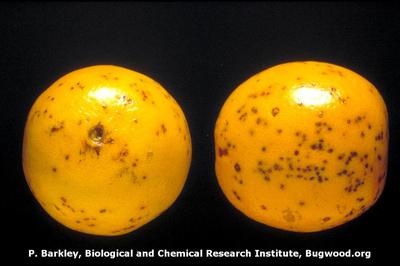Citrus Black Spot
Phyllosticta citricarpa
Fungus
In a Nutshell
- Various spots and lesions mark the skin of the fruits. Infections are usually latent until fruits become fully grown or mature. Symptoms generally occur on the sunny side of trees.
Can also be found in
Symptoms
The fungus results in different types of symptoms, mainly observed on fruits. Hard spot lesions are several millimeters in diameter. These spots are crater-like with a light center, a dark-brown to black rim, and often have a green halo on mature orange fruit. False melanose shows as raised dark-brown to black specks that may coalesce on green fruits. Freckle spots are orange to red, flattened, 1-3 mm in diameter and occur late in the season. The spots turn brown with age. Virulent spots are large, slightly sunken and spread irregularly over large areas of the mature fruit. Leaf lesions are uncommon but sometimes appear on lemon trees as small, sunken necrotic spots with light center and a dark rim and may have a chlorotic halo.
Recommendations

Organic Control
Spore monitoring through traps and rainfall and dew measurements can help to determine the timing for fungicide application. A number of copper products can be used against this pathogen. Post-harvest treatments with hot water or waxing of the fruits also decrease the viability of the pathogen and the manifestation of symptoms.

Chemical Control
Always consider an integrated approach with preventive measures together with biological treatments if available. Preharvest sprays of benzimidazole fungicides can be used preventively to delay the symptoms on fruits during transport or storage. Treatments with guazatine or imazalil decrease the viability of the pathogen in black spot lesions. Fungicides such as strobilurins, dithiocarbamates and benzimidazoles are also efficient against the fungus, but resistances have also developed in many areas.
What caused it?
The fungus overwinters in leaf debris and start to produce spores during the spring, a process that is accelerated by successive wetting and drying of the leaf litter. Spores are ejected during rainfall or irrigation, dispersed by wind and water and germinate upon landing on susceptible tissue. Leaves are vulnerable up to 10 months of age, fruits during the 4–5 months after fruit set. After infection, the fungus colonizes the area between the cuticle and the epidermis. The infection remains dormant and invisible, until the fruit is mature. The infection in leaves usually remains latent, but leaf spots may be found on older leaves. The leaf lesions usually produce spores in a gelatinous mass, which dissolves under wet conditions. The disease spreads rapidly through frequent rainfalls or splashes of water.
Preventive Measures
- Use healthy plant material from certified sources.
- Plant resistant varieties, if available.
- Air flow in the citrus grove should be maximized to reduce leaf wetness.
- Monitor the orchard regularly for signs of the disease.
- Fertilize your crop properly to increase the natural resistance of the plant.
- Remove infected plant material during the season and off-season and destroy it immediately (by burning, burying in a landfill, or feeding to livestock).
- Keep fruits as cold and dry as possible to slow development of the lesions during storage.



